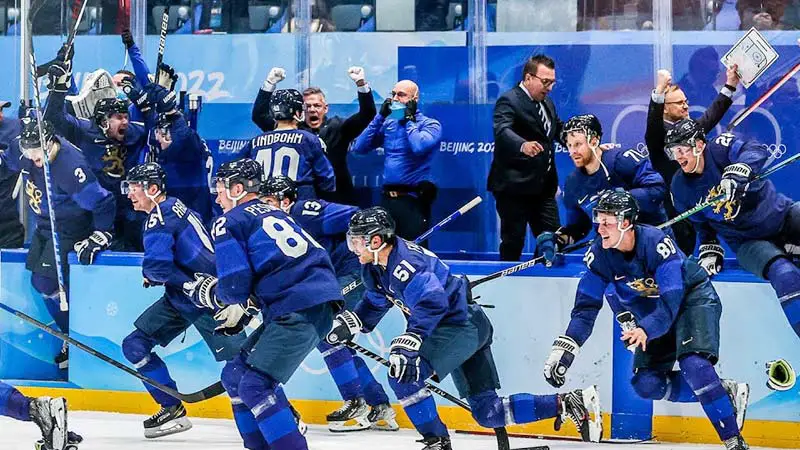Hockey, a sport that transcends boundaries and freezes hearts with its breathtaking speed and skill, has entrenched itself as a global phenomenon.
From the frenetic arenas of the National Hockey League (NHL) to the sprawling fields where field hockey reigns supreme, the popularity of hockey is a compelling tale of fervent fandom and cultural significance.
In this exploration, we delve into the factors of how popular is hockey, examining its prominence in diverse nations and the impact of major leagues and tournaments on the sport’s global allure.
As we navigate the icy rinks and vibrant fields, we uncover the role of technology, international competitions, and the passionate communities that contribute to hockey’s status as more than just a game. So, stay sharp and read the whole post.
Historical Milestones in the Popularity of Hockey
Hockey, a fast-paced and dynamic sport, has a rich history marked by various milestones that have contributed to its global popularity.
From its early origins to contemporary achievements, these milestones have shaped the narrative of hockey and cemented its status as a beloved sport worldwide.
Origin and Spread
Hockey’s roots can be traced back to ancient civilizations, with evidence suggesting variations of the game played by early cultures.
However, the modern form of hockey, particularly field hockey and ice hockey, gained prominence in the 19th century.
The formation of the first organized hockey associations and leagues during this period laid the foundation for the sport’s popularity.
As the game evolved, it spread across continents, attracting players and enthusiasts from diverse cultures.
Inclusion in the Olympics
A pivotal moment in hockey’s history was its inclusion in the Olympic Games.
The sport made its Olympic debut in 1908 (for men) and 1980 (for women). The global stage provided hockey with unprecedented exposure, leading to increased interest and participation.
The competitive nature of Olympic hockey tournaments further fueled the sport’s popularity, making it a focal point of international athletic competition.
The Miracle on Ice
The 1980 Winter Olympics in Lake Placid, USA, witnessed one of the most iconic moments in hockey history the “Miracle on Ice.”
The relatively inexperienced United States ice hockey team, comprised of amateur and college players, triumphed over the heavily favored Soviet Union team in a stunning upset.
This underdog victory captured the world’s imagination, significantly boosting the sport’s popularity in the United States and beyond.
NHL Expansion and Globalization
The National Hockey League (NHL), established in 1917, played a crucial role in popularizing ice hockey, especially in North America.
However, the league’s expansion in the late 20th and early 21st centuries had a global impact. With the inclusion of teams from Europe and the promotion of international talent, the NHL became a truly global league.
The participation of international stars and the growing fan base outside North America contributed to hockey’s increasing popularity on a worldwide scale.
Technological Advancements and Media Exposure
The advent of technology and the rise of media platforms significantly enhanced hockey’s accessibility and visibility.
Television broadcasts, live streaming, and social media platforms have brought the game to millions of fans globally, allowing them to follow their favorite teams and players in real-time.
Technological innovations, such as advanced equipment and interactive fan experiences, have further enriched the hockey-watching experience, contributing to the sustained popularity of the sport.
How Popular Is Hockey In Modern Days?

Hockey remains a popular and thriving sport in modern times, with a global fan base that spans continents.
The sport’s popularity is evident through the widespread participation at various levels, from grassroots programs to professional leagues.
Major hockey leagues, such as the National Hockey League (NHL) in North America and prominent European leagues, attract millions of viewers, showcasing the sport’s enduring appeal.
The globalization of hockey is underscored by the diverse backgrounds of players in elite leagues, fostering international interest and fostering a sense of inclusivity.
Furthermore, the sport’s prominence in major international tournaments, like the Winter Olympics and the IIHF World Championships, amplifies its global reach.
The accessibility of hockey through television broadcasts, online streaming, and social media further bolsters its popularity, ensuring that fans worldwide can engage with the excitement and intensity of this fast-paced game.
NHL’s Impact on the Popularity of Hockey
The National Hockey League (NHL) stands as a cornerstone in the world of hockey, playing a pivotal role in shaping the sport’s global popularity.
Established in 1917, the NHL has significantly influenced the trajectory of hockey, contributing to its widespread appeal and capturing the imaginations of fans across the globe.
Elite Level Competition
The NHL serves as the pinnacle of professional hockey, showcasing the highest level of skill, athleticism, and competitiveness.
The intense and thrilling nature of NHL games attracts a vast audience, drawing in both dedicated hockey enthusiasts and casual sports fans.
The league’s emphasis on top-tier competition elevates the overall perception of hockey as a dynamic and exhilarating sport.
Global Talent and Diversity
The NHL has evolved into a melting pot of international talent, with players from various countries contributing to the league’s competitive landscape.
The inclusion of stars from Europe, Russia, and other hockey-loving nations has not only diversified the game but also broadened its global appeal.
Fans worldwide can connect with players from their own countries, fostering a sense of pride and international camaraderie.
Media Exposure and Broadcasting
The NHL’s strategic approach to media coverage and broadcasting has played a crucial role in expanding the sport’s audience.
Through partnerships with television networks, online streaming services, and social media platforms, the league ensures that hockey enthusiasts can access games and content easily.
The widespread availability of NHL broadcasts has been instrumental in cultivating a dedicated fan base, transcending geographical boundaries.
Iconic Moments and Memorable Events
The NHL has been a stage for iconic moments and historic events that have left an indelible mark on the sport’s history.
From legendary rivalries to dramatic playoff matchups, these captivating narratives have added layers of excitement and drama to the league.
Moments like Wayne Gretzky’s record-breaking achievements and Stanley Cup Finals nail-biters have not only captivated existing fans but also served as entry points for new enthusiasts, contributing to the enduring popularity of hockey.
Community Engagement and Grassroots Initiatives
Beyond the glitz and glamour of professional competition, the NHL actively engages with communities and invests in grassroots initiatives.
Youth development programs, community outreach, and educational initiatives aimed at promoting hockey at the grassroots level have fostered a new generation of fans.
The league’s commitment to community building ensures that the love for hockey is cultivated from an early age, sustaining its popularity for years to come.
The Significance of the Hockey Winter Olympics

The Hockey Winter Olympics stand as a pinnacle in the sport, bringing together elite athletes from around the world to compete at the highest level on the international stage.
This prestigious event not only showcases the skill and determination of hockey players but also holds profound significance for the sport and its global community.
International Unity and Sportsmanship
The Hockey Winter Olympics symbolize a rare moment of international unity and sportsmanship. Athletes from diverse backgrounds and cultures converge to compete under their respective national flags.
The spirit of camaraderie and fair play that permeates the tournament fosters a sense of global togetherness, transcending political and cultural differences.
Elevating the Sport’s Profile
The Winter Olympics provide a unique platform for hockey to capture a global audience beyond its traditional fan base.
The intense competition and the pursuit of Olympic gold elevate the sport’s profile, attracting attention from fans who may not regularly follow hockey.
The global spotlight on the tournament amplifies the excitement and drama of the game, contributing significantly to the sport’s overall popularity.
National Pride and Identity
For participating nations, success in Olympic hockey carries immense significance. The tournament becomes a stage for countries to showcase their hockey prowess and instill national pride.
The iconic moments and victories at the Winter Olympics resonate deeply with fans, creating lasting memories that become an integral part of a nation’s sporting identity.
Development and Inspiration for Future Generations
The Hockey Winter Olympics serve as a source of inspiration for aspiring athletes, particularly young hockey enthusiasts.
Witnessing their sporting idols compete on the grand Olympic stage motivates the next generation of players.
The exposure to high-level competition and the demonstration of sportsmanship at the Olympics can fuel a passion for hockey, leading to increased participation and talent development in the sport.
Cultural Exchange and Appreciation
The tournament facilitates cultural exchange as teams and fans from various nations come together. Hockey fans globally have the opportunity to appreciate different styles of play, traditions, and fan cultures.
This cross-cultural interaction not only enriches the global hockey community but also promotes understanding and appreciation for the diversity within the sport, fostering a sense of connectedness among fans worldwide.
Role of Media and Technology to Increase the Popularity of Hockey

In the contemporary landscape, the role of media and technology has been instrumental in shaping the popularity and reach of hockey.
The marriage of traditional broadcasting methods with cutting-edge technological advancements has created a dynamic platform for fans to engage with the sport like never before.
Global Accessibility through Broadcasting
Media, particularly television broadcasting, has played a crucial role in making hockey accessible to a global audience.
Major leagues such as the NHL and international tournaments are broadcast across various networks, allowing fans from different time zones and regions to follow their favorite teams and players.
This global accessibility has significantly broadened the sport’s fan base.
Live Streaming and On-Demand Platforms
The advent of live-streaming services and on-demand platforms has revolutionized how fans consume hockey content.
Platforms like NHL.tv and other streaming services provide fans the flexibility to watch games in real-time or catch up on highlights at their convenience.
This shift towards digital platforms has catered to the preferences of modern viewers, contributing to increased engagement.
Interactive Fan Experiences
Technology has enabled interactive and immersive fan experiences, enhancing the overall enjoyment of hockey.
From virtual reality (VR) experiences to augmented reality (AR) applications, fans can now engage with the sport in innovative ways.
Virtual arenas, interactive statistics, and behind-the-scenes content create a more personalized and engaging connection between fans and the game.
Social Media Amplification
Social media platforms have emerged as powerful tools for amplifying the popularity of hockey.
Teams, players, and leagues leverage platforms like Twitter, Instagram, and Facebook to share real-time updates, highlights, and engaging content.
The viral nature of social media helps in creating buzz around key moments, fostering a sense of community among fans and contributing to the sport’s overall visibility.
Advanced Analytics and Insights
Technology has facilitated the rise of advanced analytics and data-driven insights in hockey.
Fans now have access to a wealth of statistics, player performance metrics, and in-depth analysis, enhancing their understanding of the game.
This data-driven approach not only appeals to the analytical mindset of fans but also deepens their appreciation for the strategic nuances of hockey, fostering a more informed and engaged fan base.
The symbiotic relationship between media, technology, and hockey has transformed the sport into a dynamic and globally embraced spectacle.
FAQs
How popular is hockey globally?
Hockey enjoys widespread popularity globally, with millions of fans across continents. Major leagues like the NHL and international tournaments, including the Olympics, contribute to its global appeal.
The sport’s dynamic nature, cultural significance, and diverse player base make it a beloved pastime for enthusiasts worldwide.
Which countries are hockey powerhouses?
Traditional hockey powerhouses include Canada, the United States, Russia, Sweden, and Finland. These nations have a rich hockey history, consistently producing top-tier talent.
The National Hockey League (NHL) serves as a global stage, attracting players from various countries and contributing to the sport’s international prominence.
How has technology impacted hockey’s popularity?
Technology has significantly enhanced hockey’s popularity by enabling global accessibility through broadcasting and live streaming.
Interactive fan experiences, social media engagement, and advanced analytics contribute to a more immersive and informed fan experience.
The marriage of technology and the sport has broadened its reach and deepened fan engagement.
Is hockey more popular on ice or in field formats?
The popularity of hockey varies by region and culture. Ice hockey, predominant in North America, Europe, and Russia, has a massive following.
Field hockey, especially in countries like India, the Netherlands, and Australia, is also immensely popular. Both versions contribute uniquely to the global appeal of the sport.
How does the Winter Olympics impact hockey’s popularity?
The Winter Olympics significantly boosted hockey’s popularity by providing a global stage for elite competition.
The tournament fosters international unity, elevates the sport’s profile, and becomes a source of national pride for participating countries.
The event inspires future generations, promotes cultural exchange, and plays a pivotal role in shaping hockey’s global narrative.
Wrapping Up
In the realm of sports, hockey stands as a testament to the universal language of competition and camaraderie.
Its popularity, showcased through the fervor of fans across continents, echoes not only in the thunderous cheers of crowded arenas but also in the quiet enthusiasm of local communities.
From the historic rivalries on the ice to the skillful maneuvers on the field, hockey’s journey through cultures and nations reflects a shared passion that knows no borders.
The resounding resonance of hockey’s popularity serves as a reminder, a reminder that amidst the diverse tapestry of global sports, the timeless charm and excitement of hockey continue to captivate hearts, making it an enduring force in the world of athletic pursuits. Thank you for your time.








James Felix